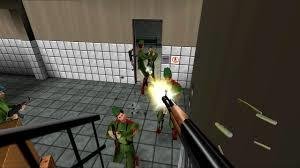The Iconic Pac-Man Ghost: Everything You Need to Know

The Pac-Man ghost is one of the most recognizable characters in video game history. Introduced in the classic arcade game Pac-Man in 1980, these ghosts have captured the imaginations of gamers for decades. But what makes the Pac-Man ghost so iconic? In this blog post, we’ll dive into everything you need to know about the Pac-Man ghost, from their different names to their unique behaviors, and how they’ve become an essential part of pop culture Pacman Ghost.
The Origins of the Pac-Man Ghost
The Pac-Man ghost was created by Japanese game designer Toru Iwatani as part of the original Pac-Man game. Iwatani wanted to create a non-violent game that appealed to both men and women, and the concept of a maze chase game featuring a yellow character and colorful ghosts was born. The Pac-Man ghost was designed to be both cute and menacing, creating a perfect balance that would make the game exciting without being too scary.
The Four Pac-Man Ghosts and Their Names
Each Pac-Man ghost has its name and personality, which adds depth to the gameplay. The original Pac-Man ghosts are Blinky (red), Pinky (pink), Inky (cyan), and Clyde (orange). These names are not just for show; they reflect the unique behavior of each Pac-Man ghost Pacman Ghost. Blinky, for example, is known as the “chaser” because he always follows Pac-Man, while Pinky tries to position himself in front of Pac-Man’s path. Understanding the different strategies of each Pac-Man ghost can give players an edge in the game.
The Pac-Man Ghost AI: How They Chase Pac-Man
One of the most fascinating aspects of the Pac-Man ghost is its AI (artificial intelligence). Each Pac-Man ghost has a specific behavior pattern that dictates how they move around the maze. Blinky, the red Pac-Man ghost, directly chases Pac-Man. Pinky, the pink Pac-Man ghost, attempts to ambush Pac-Man by predicting his path Pacman Ghost. Inky, the cyan Pac-Man ghost, uses a combination of Blinky’s position and Pac-Man’s location to create a complex strategy. Lastly, Clyde, the orange Pac-Man ghost, alternates between chasing Pac-Man and wandering off in random directions. This diversity in behavior makes every encounter with a Pac-Man ghost unpredictable and thrilling.
The Pac-Man Ghost Colors and What They Represent
The bright and distinctive colors of each Pac-Man ghost make them instantly recognizable. The red Pac-Man ghost, Blinky, represents danger and is the most aggressive. Pinky, the pink Pac-Man ghost, embodies ambush and cunning. Inky, the cyan Pac-Man ghost, is unpredictable and erratic, while Clyde, the orange Pac-Man ghost, is often seen as the odd one out due to his random movements. These colors are not just aesthetic choices but are closely tied to each Pac-Man ghost’s role in the game.
How the Pac-Man Ghosts Have Evolved Over Time
Over the years, the Pac-Man ghost has appeared in various versions of the game, each with slight changes in behavior and appearance. In some versions, the Pac-Man ghost becomes faster as the game progresses, increasing the challenge. In others, new types of Pac-Man ghosts are introduced, each with their unique traits. Despite these changes, the core identity of the Pac-Man ghost has remained the same, maintaining its status as a timeless gaming icon.
Pac-Man Ghosts in Popular Culture
The Pac-Man ghost has transcended the gaming world and has become a cultural symbol. From appearances in TV shows and movies to being featured on merchandise like T-shirts and toys, the Pac-Man ghost is a beloved figure in pop culture. The simplicity of the Pac-Man ghost design makes them instantly recognizable, even to those who have never played the game. Their influence can be seen in other games as well, where similar ghostly enemies chase players in maze-like environments.
The Role of the Pac-Man Ghost in Modern Gaming
Even in today’s advanced gaming world, the Pac-Man ghost continues to inspire game developers. The idea of enemies with distinct AI patterns can be found in many modern games. The Pac-Man ghost has set a precedent for how enemies can be designed to create a more engaging and strategic gaming experience. Whether in retro-inspired games or entirely new creations, the spirit of the Pac-Man ghost lives on.
How to Outsmart a Pac-Man Ghost: Tips and Tricks
Defeating a Pac-Man ghost requires strategy and quick thinking. One common tactic is to use the power pellets scattered around the maze. When Pac-Man eats a power pellet, the Pac-Man ghost turns blue and becomes vulnerable, allowing Pac-Man to eat them. Timing is crucial here, as the Pac-Man ghost will eventually revert to its original form. Another strategy is to learn the specific behavior of each Pac-Man ghost, using their predictable patterns to your advantage.
Fun Facts About the Pac-Man Ghosts
Did you know that the Pac-Man ghost has different names in different regions? For example, in Japan, the Pac-Man ghost Blinky is known as “Oikake” (Chaser), while Pinky is called “Machibuse” (Ambusher). Additionally, the Pac-Man ghost doesn’t actually “see” Pac-Man but follows a set of rules that dictate their movements. These little-known facts about the Pac-Man ghost add another layer of intrigue to the game.
The Future of the Pac-Man Ghost
As technology advances, the Pac-Man ghost will likely continue to evolve. With virtual reality and augmented reality becoming more prevalent, we might see the Pac-Man ghost in entirely new gaming environments Pacman Ghost. However, no matter how much they change, the core concept of the Pac-Man ghost will always remain a beloved part of gaming history.
Conclusion
The Pac-Man ghost is more than just an enemy in a video game; they are a symbol of the creativity and innovation that defined the early days of gaming. From their distinct colors to their unique AI behaviors, each Pac-Man ghost plays a crucial role in making Pac-Man the timeless classic it is today. Whether you’re a seasoned gamer or someone discovering the Pac-Man ghost for the first time, there’s no denying their impact on the world of video games.



